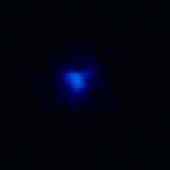ESA Science & Technology - Science Results
Science Results
Science Results
ESA's Gaia mission has produced the richest star catalogue to date, including high-precision measurements of nearly 1.7 billion stars and revealing previously unseen details of our home Galaxy.
Published: 25 April 2018
Gaia's first data release was not designed to be a full database with which major scientific discoveries could be made. Instead it was foreseen much more as a set of test data that astronomers could practice on and get ready for the second release from ESA's billion-star surveyor – the one that would feature a billion parallaxes and proper...
Published: 20 April 2018
The first data release of ESA's Gaia satellite provided a surprising number of scientific results. Yet it is nothing but a tease for what is expected from the second data release, scheduled for 25 April.
Published: 20 April 2018
Astronomers using ESA's XMM-Newton space observatory have probed the gas-filled haloes around galaxies in a quest to find 'missing' matter thought to reside there, but have come up empty-handed – so where is it?
Published: 18 April 2018
While charting the positions of more than a billion stars, ESA's Gaia mission provides all-important information even about the dark patches of the sky where fewer stars are observed. These images, based on Gaia's first data release, are an appetizer to the astronomical riches that will be unleashed with the mission's second release on 25 April.
Published: 3 April 2018
An international team of researchers using the NASA/ESA Hubble Space Telescope and several other observatories have, for the first time, uncovered a galaxy in our cosmic neighbourhood that is missing most – if not all – of its dark matter.
Published: 28 March 2018
ESA's INTEGRAL space observatory has witnessed a rare event: the moment that winds emitted by a swollen red giant star revived its slow-spinning companion, the core of a dead star, bringing it back to life in a flash of X-rays.
Published: 5 March 2018
An international team of scientists has used the NASA/ESA Hubble Space Telescope to study the atmosphere of the hot exoplanet WASP-39b. By combining this new data with older data they created the most complete study yet of an exoplanet atmosphere.
Published: 1 March 2018
Last year, ESA's Gaia mission helped astronomers make unique observations of Neptune's largest moon, Triton, as it passed in front of a distant star. This is a preview of the superb quality and versatility of the Gaia data that will be released in April.
Published: 27 February 2018
In 2014, ESA's XMM-Newton spotted X-rays emanating from the massive star Rho Ophiuchi A and, last year, found these to ebb and flow periodically in the form of intense flares – both unexpected results. The team has now used ESO's Very Large Telescope to find that the star boasts a strong magnetic field, confirming its status as a cosmic lighthouse.
Published: 26 February 2018
As inhabitants of the third rock from the Sun, we have a vested interest in understanding our home planet and its environment. Among the flotilla of spacecraft that have been sent to investigate Earth from space are the four spacecraft of the Cluster mission.
Published: 8 February 2018
The Red Planet's low gravity and lack of magnetic field makes its outermost atmosphere an easy target to be swept away by the solar wind, but new evidence from ESA's Mars Express spacecraft shows that the Sun's radiation may play a surprising role in its escape.
Published: 8 February 2018
An international team of astronomers has used the NASA/ESA Hubble Space Telescope to look for atmospheres around four Earth-sized planets orbiting within or near TRAPPIST-1's habitable zone. The new results further support the terrestrial and potentially habitable nature of three of the studied planets.
Published: 5 February 2018
The LISA Pathfinder mission already outperformed itself in the first week of operations, and now the final report card is in, showing that it even surpassed some of the requirements for its next-generation successor.
Published: 5 February 2018
ESA's XMM-Newton has spotted surprising changes in the powerful streams of gas from two massive stars, suggesting that colliding stellar winds don't behave as expected.
Published: 2 February 2018
For the first time, scientists have estimated how much energy is transferred from large to small scales within the magnetosheath, the boundary region between the solar wind and the magnetic bubble that protects our planet.
Published: 29 January 2018
Immense northern storms on Saturn can disturb atmospheric patterns at the planet's equator, finds the international Cassini mission. This effect is also seen in Earth's atmosphere, suggesting the two planets are more alike than previously thought.
Published: 13 December 2017
Astronomers have used ESA's Herschel Space Observatory to solve a decades-old mystery about the origin of powerful cool gas winds in the hot environs of quasars. The evidence linking these powerful winds to star formation in the quasar host galaxies may also help resolve the mystery of why the size of galaxies in the Universe appears to be capped.
Published: 7 December 2017
A team of astronomers used data from both the NASA/ESA Hubble Space Telescope and ESA's Gaia satellite to directly measure the 3D motions of individual stars in a nearby galaxy.
Published: 27 November 2017
By pinning down, for the first time, the three-dimensional motions of individual stars in the nearby Sculptor dwarf galaxy, astronomers have shed new light on the distribution of invisible dark matter that pervades the galaxy.
Published: 27 November 2017
—
20 Items per Page




















